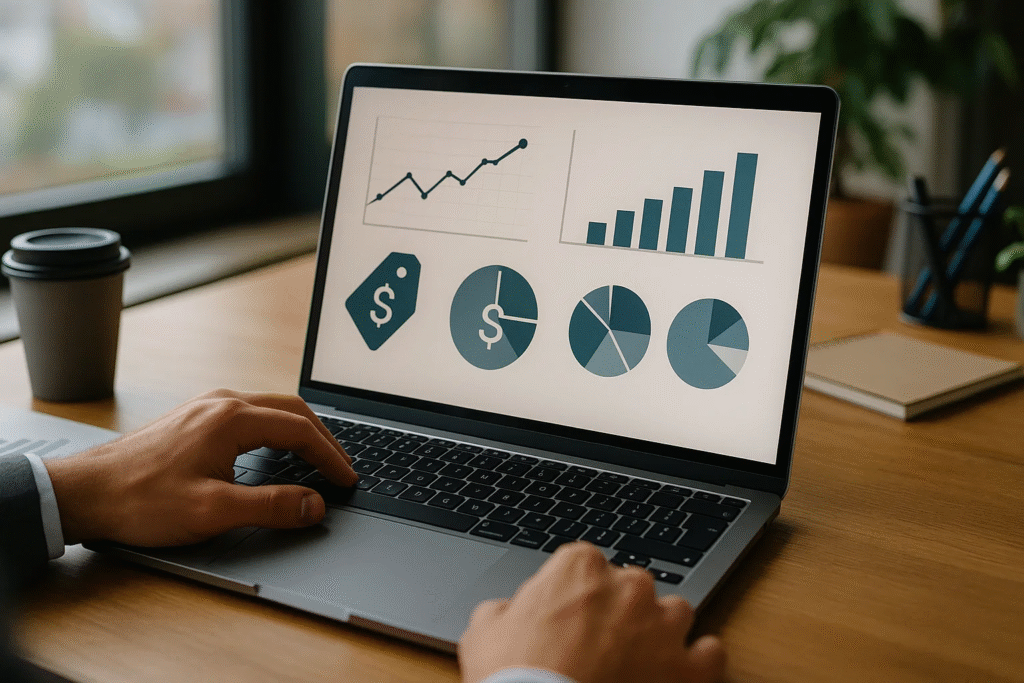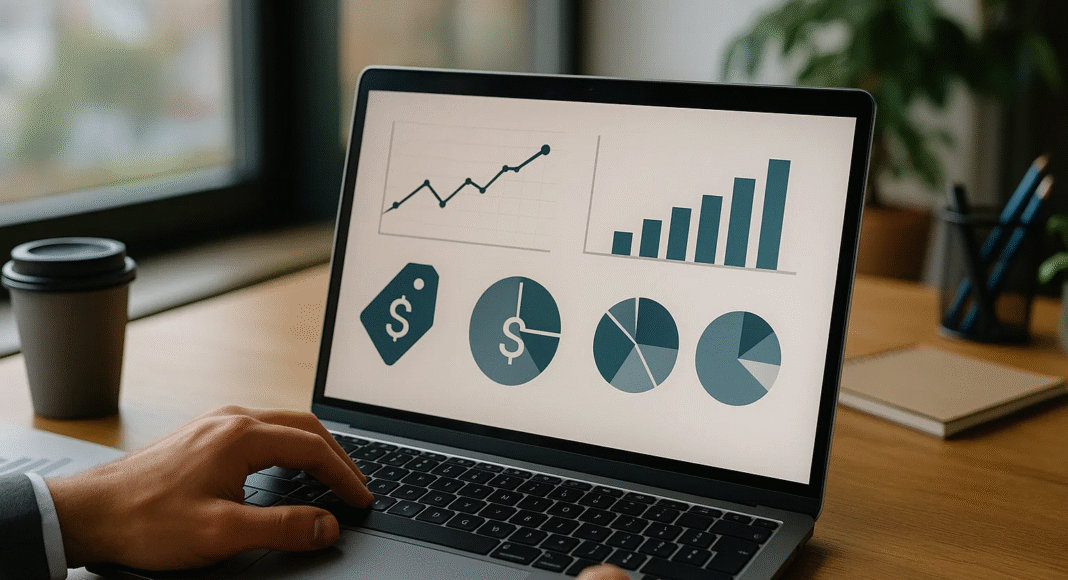Key Takeaways
- AI-driven competitor price monitoring tools in 2025 enable real-time pricing intelligence, dynamic repricing, and predictive analytics for better profit control.
- Businesses are integrating price monitoring systems with ERP and eCommerce platforms to automate data insights and maintain competitive pricing strategies.
- Ethical pricing, data transparency, and compliance are becoming central as algorithmic pricing evolves under stricter global regulations.
In 2025, competitor price monitoring software has moved from a tactical advantage to an operational necessity for retailers, brands, and marketplaces that compete in hyper-competitive digital channels. As marketplaces proliferate, consumer choice deepens and margins tighten, organisations no longer rely on intuition or periodic manual checks to understand pricing landscapes; they require continuous, automated visibility into competitor listings, promotional activity, and price movements across geographies and channels. This introduction synthesises the most consequential market indicators, behavioural shifts, and technological accelerants shaping price-monitoring strategies today, and it frames why the fifty leading tools profiled in this report matter for revenue, margin management, and customer perception.
Also, read our top guide on the Top 10 Best Competitor Price Monitoring Software in 2025.

Market expansion and commercial pressure are driving broad adoption. Pricing and dynamic-pricing platforms are expanding rapidly as businesses seek automated systems that ingest competitor data, customer demand signals, inventory levels, and promotional calendars to generate prescriptive pricing actions. Investment in specialised pricing tools is being propelled by a rising expectation that pricing decisions be both data-driven and real-time; organisations want systems that reduce manual latency, eliminate human error, and identify short windows of pricing opportunity before competitors respond. The consequence is a richer product feature set across the industry: multicurrency scraping at scale, MAP (minimum advertised price) enforcement, parity checks across marketplaces, automated repricing rules, and close integration with commerce stacks and inventory systems.
Artificial intelligence and advanced analytics are now table stakes. Machine learning models have moved beyond simple rule engines to probabilistic forecasting and elasticity estimation, where the software predicts competitor responses, estimates demand sensitivity to price delta, and recommends optimal trade-offs between conversion and margin. These capabilities enable firms to implement segmented pricing strategies—differentiating by customer cohort, channel, or region—while preserving compliance with retail agreements and regulatory considerations. At the same time, concerns about personalization, fairness, and regulatory scrutiny are influencing how vendors design pricing logic and data governance; transparency and explainability of AI-driven price decisions are becoming selling points for enterprise buyers.
Data quality and collection scale are central competitive differentiators. The usefulness of any price-monitoring platform is governed by the breadth of its coverage (how many retailers, SKUs, and channels it tracks), the freshness of its data (near real-time versus hourly or daily feeds), and the fidelity of the metadata it captures—promotions, shipping costs, bundle rules, stock status, and seller identity. Vendors that combine high-frequency scraping with normalization, enrichment (reviews, ratings, content differences), and durable historical stores enable customers to run sophisticated trend analyses: seasonal effects, promotional lift, and long-term price erosion. For categories where MAP and gated pricing are material, features such as automatic anomaly detection and alerting are essential risk-management tools.
Commerce is being reshaped by new distribution and discovery models, which change how pricing intelligence must be applied. AI shopping agents, federated marketplaces, and voice/assistant-driven commerce alter where and how consumers find products; visibility into these emerging touchpoints is now a strategic frontier. Pricing vendors that index marketplaces, comparison engines, and the new AI-driven shopping ecosystems will give clients earlier insight into visibility shifts and the competitive responses that follow. The shift also elevates the importance of SEO, catalog enrichment, and content parity as complementary levers to pricing alone.
Sizing, ROI, and buyer expectations are converging on measurability. Buyers evaluating price-monitoring platforms increasingly demand evidence of measurable outcomes—margin preservation, uplift in conversion from dynamic repricing, reduced MAP violations, or faster time-to-reaction during promotions. This demand has encouraged vendors to offer clearer ROI frameworks, case studies with revenue impact metrics, and piloting programs that map technical capability to business KPIs. For procurement teams, total cost of ownership now includes not only subscription fees but also integration effort, data privacy considerations, and the operational models required to act on insights.
Risk, ethics, and regulation are reshaping vendor and buyer behaviour. As dynamic and algorithmic pricing grows, regulators and advocacy groups globally are scrutinising opaque pricing practices that could disadvantage consumers or facilitate discriminatory outcomes. Vendors are responding with features that support audit trails, controlled experiment frameworks, and constrained optimization options that respect legal and ethical guardrails. For buyers, the trade-off between aggressive price capture and reputational/regulatory exposure is no longer theoretical; it is a procurement discussion that influences vendor selection.
Operational integration and ease of activation determine long-term value. The most useful systems are not isolated dashboards but integrated platforms that feed pricing decisions into ERP, OMS, and ad spend strategies. Successful deployments emphasise clean data contracts, automation of repricing rules, and role-based workflows that ensure pricing changes propagate without manual bottlenecks. Businesses that pair a strong technical implementation with clear governance (who can change prices, who reviews exceptions, how to rollback) extract far more value from price monitoring than those that treat the software as a standalone insight tool.
Looking ahead, the interplay between automation and human judgement will define winners. The 2025 market favours platforms that provide reliable automation tuned by human strategy—systems that enable rapid A/B testing of price strategies, simulate competitor responses, and present clear, actionable recommendations rather than opaque scores. The fifty solutions examined in this report vary by their approach to data coverage, AI sophistication, integration depth, and risk-management features; together they paint a market in which technical differentiation and go-to-market alignment with commercial teams determine adoption.
Before we venture further into this article, we would like to share who we are and what we do.
About 9cv9
9cv9 is a business tech startup based in Singapore and Asia, with a strong presence all over the world.
With over nine years of startup and business experience, and being highly involved in connecting with thousands of companies and startups, the 9cv9 team has listed some important learning points in this overview of the Top 50 Competitor Price Monitoring Software Statistics, Data & Trends in 2025.
If your company needs recruitment and headhunting services to hire top-quality employees, you can use 9cv9 headhunting and recruitment services to hire top talents and candidates. Find out more here, or send over an email to [email protected].
Or just post 1 free job posting here at 9cv9 Hiring Portal in under 10 minutes.
Top 50 Competitor Price Monitoring Software Statistics, Data & Trends in 2025
- The global market for competitor price monitoring software was estimated to be worth approximately $2 billion in 2025 and is projected to escalate towards $6 billion by 2033, representing a robust compound annual growth rate (CAGR) of about 15% from 2025 onwards.
- The price monitoring software market size was recently valued around $1.92 billion in 2025, with forecasts suggesting it will expand to $5.09 billion by 2033 at a CAGR of roughly 10.5%.
- In the UK, the price monitoring software segment’s market is approximately valued at £450 million in 2025 and is experiencing an annual growth rate of 34%, emphasizing the sector’s rapid regional expansion.
- Over 87% of UK retailers employ some form of price monitoring technology, while more than 2,300 UK firms have adopted such tools to stay competitive.
- Globally, eCommerce sales alone are expected to reach $6.86 trillion in 2025, increasing pressure on businesses to utilize advanced competitive pricing solutions.
- The latest (2025+) competitor price monitoring tools are characterized by predictive analytics, market simulation, and autonomous optimization capabilities, which are crucial for real-time decision-making in highly competitive markets.
- Cloud-based competitor price monitoring solutions dominate the market due to their scalability, affordability, and ease of deployment, accounting for the majority market share, while traditional on-premise systems decline in popularity.
- Leading providers such as Prisync, Price2Spy, PriceLabs, Competera, and PriceShape have introduced advanced features like price history tracking, MAP violation detection, assortment gap analysis, and automated repricing, enabling businesses to react swiftly in competitive environments.
- PriceLabs launched automated pricing features in 2021, and Price2Spy developed a mobile app in 2023, exemplifying ongoing innovation among leading software vendors.
- Forecasts indicate an increasing presence of AI and machine learning in competitor price monitoring tools, with ongoing trends pointing towards more integrated, predictive, and real-time monitoring solutions to sustain competitive advantage.
- The growth in competitor price monitoring software will be supported by expanding e-commerce markets, especially in Asia-Pacific, which is expected to see the fastest expansion due to rising digitalization and online shopping behaviors.
- Approximately 78% of UK consumers check at least two online retailers to compare prices before making a purchase, which encourages adoption of price monitoring tools by businesses.
- Over 70% of online retailers in Europe reported using automated competitor price monitoring tools in 2024, up from 58% in 2022.
- For mid-market retailers, the starting monthly cost for using Prisync’s competitor monitoring solution is $99 in 2025.
- Leading cloud-based pricing intelligence software now collects and analyzes data from over 300 million SKUs worldwide each month.
- Real-time price monitoring tools can track upwards of 10,000 competitor prices per retailer every minute across various e-commerce channels in 2025.
- Over 50% of retailers with annual revenue above $10 million have implemented some form of dynamic pricing or competitor price tracking system.
- Automated repricing tools with monitoring capabilities enable instant price changes in response to competitor pricing shifts, with average reaction times dropping to under 2 minutes in 2025.
- Modern AI-powered competitor price monitoring tools can provide recommendations that improve retailer gross margins by an average of 4.5%.
- Between 2023 and 2025, the adoption of competitor price monitoring solutions among SMEs rose by 18% in developed markets.
- Price monitoring technologies have evolved in three generations: first generation (pre-2020) relying on manual and basic automation, second generation (2020-2023) using scheduled and event-based alerts, and third generation (2023 onwards) integrating deep learning and dynamic pricing.
- Among North American retailers, the implementation rate for competitor price monitoring software reached 64% in 2024.
- Over 40% of global retailers consider price intelligence software to be among their three most critical digital investments as of 2025.
- MAP (Minimum Advertised Price) policy violation detection features are present in more than 60% of the top 20 price monitoring tools on the market.
- Automated email and SMS alerting on competitive price changes are now offered by 88% of major solutions.
- Retailers using dynamic repricing based on competitor data saw, on average, a 7.2% increase in cart conversion rates over businesses without such technology.
- Over 80% of the top 500 online retail brands worldwide have a dedicated pricing and analytics team deploying competitor monitoring solutions.
- The global price intelligence cloud-based software sector is forecast to grow at a CAGR of 17% from 2024 to 2030.
- Analysis tools for competitor pricing now include assortment gap analysis, supported by 72% of the leading software platforms.
- A 2025 industry survey revealed that 44% of B2B eCommerce players have dedicated budget allocation for advanced competitor price tracking.
- Leading platforms have reduced the average data refresh interval to less than 15 minutes in 2025, compared to 1–3 hours in 2021.
- Competitive product assortment intelligence, such as SKU-level tracking, is offered by at least 65% of current enterprise-level platforms.
- Adoption of API integrations for competitor price feeds increased by over 120% between 2021 and 2025.
- In the Asia-Pacific region, revenue from price monitoring solutions rose by 29% between 2023 and 2025.
- The percentage of global retailers requiring omnichannel competitor price monitoring increased from 35% in 2019 to 62% in 2025.
- Over 90% of eCommerce managers surveyed in 2025 report at least weekly use of competitor price dashboards.
- Price transparency modules are now a standard requirement for RFPs in 56% of enterprise software procurement processes.
- The average return on investment (ROI) from deploying price monitoring solutions reached 540% for the top 10% of adopters according to a 2024 report.
- Over 75% of SaaS-based price monitoring vendors now offer white-label solutions for agencies and systems integrators.
- North America holds the largest market share (about 38%) for competitor price monitoring platforms as of 2025, followed by Europe at 29% and Asia-Pacific at 22%.
- Predictive pricing recommendations powered by AI are utilized by 41% of retailers with over $50 million in annual revenue in 2025.
- API-based competitor data extraction accounts for 67% of all integration requests among enterprise users.
- For multi-country brands, multilingual competitor tracking is now supported by over 57% of commercial solutions.
- Automated promotion and discount detection appeared as standard features in 82% of all enterprise competitor monitoring deployments in 2025.
- Retailers with omnichannel presence observed a 12% higher sales uplift from competitor price monitoring compared to online-only stores.
- Rate parity enforcement modules are actively used by 28% of travel and hospitality sector adopters.
- Serverless and edge-optimized implementations of price tracking agents have reduced average infrastructure costs by 34% since 2022.
- Continuous competitor assortment (off/on) monitoring is available in 66% of advanced price monitoring suites as of 2025.
- User adoption surveys show average daily logins to competitor price monitoring dashboards increased 21% from 2023 to 2025.
- Real-time alerting of new competitor entry (brand/SKU) is used by 54% of retail organizations with annual revenue exceeding $25 million.
Conclusion
As the global eCommerce and retail ecosystem becomes increasingly data-driven, 2025 has cemented competitor price monitoring software as one of the most essential technologies for maintaining market relevance, profitability, and customer trust. The competitive dynamics shaping the digital marketplace no longer allow companies to rely on static pricing or manual research. Instead, real-time data intelligence, automation, and predictive analytics now define how successful businesses manage pricing strategies, respond to market shifts, and safeguard margins against aggressive competition. The insights and statistics presented throughout this report make it clear that price monitoring has evolved from a tactical capability into a strategic business necessity.
The most significant trend reshaping the pricing intelligence landscape is the integration of artificial intelligence and machine learning across all levels of the process. AI-driven algorithms are enabling businesses to move beyond descriptive data toward predictive and prescriptive analytics, allowing decision-makers to simulate pricing outcomes, anticipate competitor movements, and optimise profitability in real-time. This technological sophistication not only reduces human error but also empowers organisations to maintain agility in volatile market environments. Moreover, adaptive pricing models are being refined through reinforcement learning, sentiment analysis, and competitor segmentation, setting a new benchmark for intelligent pricing operations.
Equally transformative is the role of data scale and accuracy. Leading price monitoring tools in 2025 are defined by their ability to aggregate and process millions of SKUs across multiple marketplaces, currencies, and categories. The competitive edge lies not just in capturing prices, but in interpreting a broad spectrum of metadata—product descriptions, discount codes, promotional strategies, stock availability, and seller ratings. This multidimensional data provides a more holistic view of competitive positioning, allowing businesses to fine-tune strategies that align pricing decisions with brand value, demand elasticity, and customer expectations. The depth of analytics now accessible to even mid-sized companies underscores how democratized and vital these technologies have become.
Integration has also emerged as a key success factor for modern enterprises deploying competitor price monitoring systems. The best-performing companies treat these platforms as core infrastructure within a larger digital ecosystem, linking them to ERP systems, inventory management, and marketing automation tools. By synchronising price data with operational workflows, businesses can automate repricing, manage promotions dynamically, and align inventory decisions with real-time market intelligence. This convergence of functions transforms raw price data into actionable business intelligence, supporting faster response times and more consistent pricing policies across channels and regions.
However, 2025 also brings to light new ethical, regulatory, and operational challenges. With algorithmic pricing becoming more sophisticated, the boundaries between competitive optimisation and anti-competitive behaviour are being carefully scrutinised by regulators worldwide. Transparent algorithms, auditable data trails, and compliance with pricing regulations are now critical factors influencing vendor selection and software implementation. Moreover, companies must ensure that automated pricing models uphold fairness, avoid bias, and maintain consumer confidence. Responsible AI governance is no longer optional—it has become integral to sustainable pricing strategies.
From a commercial perspective, the return on investment for price monitoring solutions continues to grow. Retailers and brands that have implemented real-time competitor intelligence report substantial improvements in margin control, sales volume, and pricing efficiency. Dynamic repricing powered by accurate competitor data enables businesses to strike a balance between competitiveness and profitability—maximising conversions without undermining perceived brand value. The ability to identify price anomalies, enforce MAP policies, and react immediately to competitor discounts allows enterprises to preserve both pricing integrity and long-term customer loyalty.
The evolution of consumer behaviour also underscores why price monitoring remains indispensable. Modern shoppers are digitally empowered, comparing prices across channels within seconds and demanding consistent value propositions. For businesses, this means that any pricing lag or inconsistency can result in immediate revenue loss. Continuous monitoring ensures alignment between price positioning and market expectations, safeguarding competitiveness while enhancing brand credibility. As omnichannel commerce expands, maintaining unified pricing strategies across platforms—web, mobile, and physical outlets—has become a defining challenge that only sophisticated monitoring systems can effectively address.
Looking ahead, the next frontier for competitor price monitoring will involve deeper automation, contextual AI, and advanced decision support. Future systems will not only detect price changes but will also analyse contextual variables such as weather, regional purchasing power, or seasonal demand spikes to predict optimal pricing opportunities. The integration of generative AI with dynamic pricing engines could enable automatic creation of campaign scenarios, price testing scripts, and promotional forecasting models. Moreover, interoperability with AI-driven sales assistants and marketing automation tools will further streamline end-to-end pricing optimisation.
In conclusion, the 2025 landscape of competitor price monitoring software reflects a clear convergence of technology, data intelligence, and commercial strategy. The fifty platforms highlighted in this report represent the forefront of innovation—each contributing to how businesses capture, analyse, and act on pricing data in an increasingly complex digital economy. For enterprises seeking to remain competitive in real-time markets, investing in robust, AI-enabled price monitoring systems is no longer a luxury but a strategic imperative. Companies that embrace these technologies with the right governance, integration, and analytical maturity will be best positioned to lead their industries—optimising profit margins, enhancing brand trust, and sustaining market leadership in the ever-evolving world of digital commerce.
If you find this article useful, why not share it with your hiring manager and C-level suite friends and also leave a nice comment below?
We, at the 9cv9 Research Team, strive to bring the latest and most meaningful data, guides, and statistics to your doorstep.
To get access to top-quality guides, click over to 9cv9 Blog.
To hire top talents using our modern AI-powered recruitment agency, find out more at 9cv9 Modern AI-Powered Recruitment Agency.
People Also Ask
What is competitor price monitoring software?
Competitor price monitoring software tracks and analyses competitor pricing data in real-time to help businesses adjust their pricing strategies for better market competitiveness.
Why is competitor price monitoring important in 2025?
In 2025, price monitoring helps businesses stay agile, maintain profitability, and respond instantly to market shifts driven by automation, AI, and consumer price sensitivity.
How does AI enhance competitor price monitoring?
AI automates data collection, predicts competitor actions, and recommends optimal pricing strategies using predictive analytics and machine learning algorithms.
What are the top trends in competitor price monitoring software for 2025?
Key trends include AI integration, real-time data analytics, multi-channel monitoring, and compliance-focused algorithmic pricing.
Which industries benefit most from competitor price monitoring tools?
Retail, eCommerce, travel, automotive, and consumer electronics industries benefit most due to high competition and frequent price changes.
How does price monitoring improve profitability?
By identifying optimal pricing points and monitoring competitor actions, businesses can adjust prices strategically to maximise margins and sales volume.
What data do price monitoring tools collect?
They gather product prices, discounts, stock levels, shipping costs, and promotional offers across competitors’ online and offline channels.
Are price monitoring tools suitable for small businesses?
Yes, many modern tools offer affordable plans with automated tracking and analytics, making them accessible to SMEs looking to compete effectively.
What role does automation play in price monitoring software?
Automation enables continuous data collection, instant updates, and dynamic repricing without manual intervention, saving time and improving accuracy.
How do businesses use competitor price monitoring data?
They analyse competitor trends, detect pricing gaps, enforce MAP policies, and adjust pricing to enhance their overall competitiveness and market share.
What are the leading features of top price monitoring tools in 2025?
Key features include AI analytics, real-time alerts, API integration, competitor benchmarking, and automated repricing systems.
Can price monitoring software prevent MAP violations?
Yes, many platforms include MAP compliance tools that detect and alert users about unauthorized pricing deviations across marketplaces.
How does dynamic pricing relate to competitor price monitoring?
Dynamic pricing uses competitor data to automatically adjust prices in real-time, balancing competitiveness with profitability.
What challenges do businesses face with price monitoring?
Challenges include data accuracy, managing large datasets, API limitations, and staying compliant with pricing and data regulations.
How do AI algorithms improve pricing accuracy?
AI models analyse vast data sets to predict competitor moves, calculate price elasticity, and recommend the most profitable pricing decisions.
Is competitor price monitoring legal?
Yes, as long as the data is gathered ethically and publicly without violating data privacy or anti-competitive laws.
How do global brands use price monitoring tools?
Global brands use them to maintain price consistency across regions, detect grey-market activities, and manage international pricing strategies.
How often should businesses monitor competitor prices?
Continuous or real-time monitoring is ideal, allowing businesses to respond immediately to competitor price changes and promotional campaigns.
What metrics are most important in price monitoring analytics?
Key metrics include price index, margin impact, stock availability, market position, and promotional response rate.
Can competitor price monitoring software integrate with ERP or CRM systems?
Yes, most modern platforms offer integration with ERP, CRM, and eCommerce systems to automate workflows and unify data insights.
What are the benefits of using AI-driven price intelligence tools?
AI-driven tools improve decision-making, enable real-time repricing, and help companies forecast future pricing trends with greater accuracy.
How does price monitoring support digital transformation?
It connects data analytics, AI, and automation to streamline pricing operations, enhance agility, and support revenue optimization strategies.
Are competitor price monitoring tools secure?
Yes, reputable vendors use encryption, compliance frameworks, and secure APIs to protect sensitive data and ensure ethical data use.
What factors should businesses consider when choosing price monitoring software?
Evaluate data accuracy, AI capabilities, integration options, reporting features, scalability, and vendor support.
Can competitor price monitoring boost customer loyalty?
Yes, by ensuring fair and competitive pricing, businesses build trust, increase customer satisfaction, and improve retention.
How do pricing trends differ across industries in 2025?
Trends vary; eCommerce focuses on real-time repricing, travel uses demand forecasting, while retail emphasises omnichannel pricing alignment.
What is the ROI of competitor price monitoring software?
Businesses often see improved margins, higher conversions, and reduced manual workload, leading to significant ROI within months of deployment.
How will competitor price monitoring evolve beyond 2025?
Expect deeper AI integration, automated decision-making, and expanded data coverage across new digital marketplaces and AI-driven platforms.
What are the future challenges for price monitoring vendors?
Vendors will face increasing data privacy laws, demand for transparent AI, and the need for scalable, multi-channel global monitoring.
Why should companies invest in competitor price monitoring software now?
With digital competition intensifying in 2025, investing now ensures pricing agility, improved profitability, and long-term competitive advantage.
Sources
- DataInsightsMarket.com – “Competing Price Monitoring Software Market Consumption Trends”
- DataInsightsMarket.com – “Price Monitoring Software Market Insights”
- DataInsightsMarket.com – “Competitor Price Monitoring Software Market Size | Industry Insights”
- Repricer.com – “Best Competitive Price Monitoring Tools for eCommerce 2025”
- Repricer.com – “16 Best Competitive Pricing Tools in 2025 [+Pros & Cons]”
- Softwarereviews.com – “Competitor Price Monitoring Software”
- PriceShape.com – “Competitor Price Monitoring Tool | Price Tracking Software”
- BusinessResearchInsights.com – “Price Monitoring Software Market Size | Industry Insights”
- ScrapX.io – “Top 10 Competitor Price Monitoring Tools in 2025”
- LinkedIn.com – “Price Monitoring Software in the Real World: 5 Uses You’ll”
- PricingCraft.com – “Competitor price monitoring – Pricing Craft”
- 42Signals.com – “Competitor Price Monitoring Software – Maximizing Profits”
- ResearchBridgePublisher.com – “Price Volatility Mitigation and the Securities Market”
- RGSAnet.org – “Highlights of the Issue: Singapore Consensus – Safety Technology”
- BonVounView.com – “Building the ARIMA Model for Forecasting the Unemployment Rate”
- IOPscience.org – “Comments: Can Big Oil’s Role in Lithium Production Keep Going”
- ResearchBridgePublisher.com – “Price Volatility Mitigation and the Securities Market”
- RGSA.org – “Highlights of the Issue: Singapore Consensus – Safety Technology”
- Jurnal.stieganesha.ac.id – “Analysis of the Covid-19 Pandemic’s Impact on the Ukrainian Confectionery Market”
- S-RSA.com – “Highlights of the Issue: Singapore Consensus – Safety Technology”
- Ojs.bonviewpress.com – “Building the ARIMA Model for Forecasting the Unemployment Rate”
- OnePetro.org – “Comments: Can Big Oil’s Role in Lithium Production Keep Going”
- ResearchBridgePublisher.com – “Price Volatility Mitigation and the Securities Market”
- DinastiRes.org – “Dumping Practices on Market Balance: A Review of Business Competition in E-Commerce”
- WorldNutritionJournal.org – “The trends and effects of food price inflation on the cost and affordability of nutritionally adequate diets in Malawi”
- Semanticscholar.org (multiple references) – Various articles related to market analysis and policies
- IJIRMPS.org – “E-commerce Price Comparison Website using Web Scraping”
- Arxiv.org – “A Survey on Data Markets” and “A Survey of Data Pricing for Data Marketplaces”
- Wiley.com – “Price Comparison Websites”
- Arxiv.org – “Personalized Pricing Decisions Through Adversarial Risk Analysis”
- Arxiv.org – “A Market for Accuracy: Classification under Competition”
- IJIRRPS.org – “E-commerce Price Comparison Website…”
- ResearchBridgePublisher.com – “Price Volatility Mitigation and the Securities Market”
- RGSA.org – “Highlights of the Issue: Singapore Consensus – Safety Technology”
- UIOJ.bonviewpress.com – “Building the ARIMA Model for Forecasting the Unemployment Rate”
- ResearchBridgePublisher.com – “Price Volatility Mitigation and the Securities Market”
- Etherarxiv.org – “Personalized Pricing Decisions Through Adversarial Risk Analysis”
- Arxiv.org – “A Market for Accuracy: Classification under Competition”
- IJIRRPS.org – “E-commerce Price Comparison Website…”
- ResearchBridgePublisher.com – “Price Volatility Mitigation and the Securities Market”
- RGSA.org – “Highlights of the Issue: Singapore Consensus – Safety Technology”
- UIOJ.bonviewpress.com – “Building the ARIMA Model for Forecasting the Unemployment Rate”
- ResearchBridgePublisher.com – “Price Volatility Mitigation and the Securities Market”































![Writing A Good CV [6 Tips To Improve Your CV] 6 Tips To Improve Your CV](https://blog.9cv9.com/wp-content/uploads/2020/06/2020-06-02-2-100x70.png)


